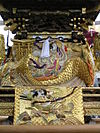- Conservation Techniques for Cultural Properties
-
In 1975 the Japanese government added a new chapter to the Law for the Protection of Cultural Properties (1950) to provide for 'traditional techniques or craftsmanship that are indispensable to the preservation of cultural property and for which preservation measures shall be taken'. Preservation techniques are selected in relation to both tangible and intangible cultural properties and a holder or preservation body is recognized for each technique.[1][2][3]
In support of the Selected Conservation Techniques (選定保存技術), the government provides funding for and conducts programmes relating to documentation, training, development, promotion and public education. Recognition is thus made and measures taken to combat some of the most serious conservation issues, namely the lack of specialist craftsmen, the loss of knowledge of traditional techniques, and the availability of suitable tools and materials. These issues are of particular relevance in Japan due to the sophistication and inherent susceptibility of much of its art and architecture.[2][3]
Contents
Selected Conservation Techniques
Tangible Cultural Properties
Name Remarks Holder Year Picture Manufacture of roof tiles (onishi) (屋根瓦製作 (鬼師) yane kawara seisaku (onishi))[4][5] Individual 1988 
Drafting of plans - kiku technique (modern) (規矩術 (近世規矩) kiku-jutsu (kinsei-kiku))[6][7] lit. 'measuring with a carpenter's square' Individual 1993 Drafting of plans - kiku technique (ancient) (規矩術 (古式規矩) kiku-jutsu (koshiki-kiku))[8][3] In particular for projecting eaves; developed since the twelfth century Individual 1991 Smithing of metal fittings (金具鍛冶 kanagu tanya)[9][10] Individual 2002 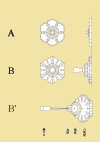
Manufacture of kinkarakami (金唐紙製作 kinkarakami-seisaku)[11][12][13] Gold-embossed wallpaper, used in western-style buildings of the Meiji to Shōwa periods; cf. kinkarakawa or 'leather wallpaper' Individual 2005 Manufacture of screens, doors and shutters (建具製作 tategu-seisaku)[14][15] Includes shōji, fusuma, amado Individual 1999 
Manufacture of architectural models (建造物模型製作 kenzōbutsu mokei-seisaku)[16] Individual 1999 
Repair of armour (甲冑修理 katchū-shūri)[17] Individual 1998 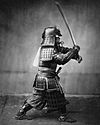
Plastering (old Kyoto walls) (左官 (古式京壁) sakan (koshiki kyō-kabe))[18] Individual 2001 
Plastering (shikkuinuri) (左官 (漆喰塗) sakan (shikkuinuri))[19][20] Glue, brine, clay, and thread are mixed into the lime Individual 1998 Repair of urushi objects (漆工品修理 shikkōhin-shūri)[21][22] Individual 1994 
Manufacture and repair of ancient decorative metalwork (上代飾金具製作修理 jōdai kazari kanagu seisaku-shuri)[23] Includes mikoshi, zushi Individual 1977 
Manufacture of tatami (畳製作 tatami-seisaku)[24] Individual 1929 
Stone tile roofing (石盤葺 sekibanbuki)[25] Individual 2005 Manufacture of bamboo nails (竹釘製作 takekugi-seisaku)[26][27] Individual 1998 Manufacture of moulds (鋳物製作 imono-seisaku)[28] Individual 1999 Manufacture of karakami (Chinese paper) (唐紙製作 karakami-seisaku)[29][30] Individual 1999 Manufacture of kiribako (paulownia storage cases) for arts and crafts (美術工芸品保存桐箱製作 bijutsu-kōgeihin hozon kiribako-seisaku)[31] Individual 1980 Manufacture of ancient textiles (such as gold brocade) for mounting (表具用古代裂 (金襴等) 製作 hyōgu-yō kodai-gire (kinran tō) seisaku)[32][33][34][35] For kakemono etc. Individual 2007 Manufacture of brushes for mounting (表具用刷毛製作 hyōgu-yō hage-seisaku)[36][37] Individual 1958 Manufacture of handmade paper (uda-gami) for mounting (表具用手漉和紙 (宇陀紙) 製作 hyōgu-yō tesuki-washi (misu-gami) seisaku)[38] Individual 1978 Manufacture of handmade paper (misu-gami) for mounting (表具用手漉和紙 (美栖紙) 製作 hyōgu-yō tesuki-washi (misu-gami) seisaku)[39] Individual 2009 Manufacture of handmade paper (hoshū-shi) for mounting (表具用手漉和紙 (補修紙) 製作 hyōgu-yō tesuki-washi (hoshū-shi) seisaku)[40] Individual 2007 Production of brush strokes for mounting (表具用打刷毛製作 hyōgu-yō uchibake-seisaku)[41] Individual 1998 Mounting on screens and doors (表装建具製作 hyōsō tategu-seisaku)[42][43][44] Individual 1995 
Indigo (本藍染 hon-aizome)[45] Individual 1996 
Repair of wooden objects (木工品修理 mokkohin-shūri)[46] Individual 1997 Harvesting of cypress bark (檜皮採取 hiwada-saishiki)[47] Individual 1999 
Manufacture of decorative metal fittings (錺金具製作 kazari kanagu-seisaku)[48][49] Individual 1998 
Tiled roofing (屋根瓦葺 (本瓦葺) yanegawarabuki (hongawarabuki))[50][51] Individual/Group 1994 
Thatching (茅葺 kayabuki)[52][53] Individual/Group 1980 
Wooden buildings (建造物木工 kenzōbutsu mokkō)[54] Individual/Group 1976 
Hinoki-bark and shake roofing (檜皮葺・柿葺 hiwada-buki/kokera-buki)[55][56][57] Individual/Group 1976 
Painted buildings (建造物彩色 kenzōbutsu-saishiki)[58] Group 1979 
Building repair (建造物修理 kenzōbutsu-shūri)[59] Group 1976 Building decoration (建造物装飾 kenzōbutsu sōshoku)[60] Group 2007 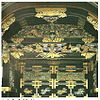
Plastering (Japanese walls) (左官(日本壁) sakan (nihon kabe))[61] Group 2002 Manufacture and repair of festival floats etc (祭屋台等製作修理 matsuri yatai tō seisaku shūri)[62][63] Group 2002 Storage equipment technology (装こう修理技術 sōkō-shūri gijutsu)[64] Group 1995 Ukiyo-e woodblock print technology (浮世絵木版画技術 ukiyo-e mokuhanga gijutsu)[65] Group 1978 
Conservation techniques for Cultural Property dry stone walls (文化財石垣保存技術 bunkazai ishigaki hozon gijutsu)[66][67] Group 2009 Conservation techniques for Cultural Property property gardens (文化財庭園保存技術 bunkazai teien hozon gijutsu)[68] Group 2002 
Repair of wooden statues (木造彫刻修理 mokuzō chōkoku-shūri)[69] Group 1976 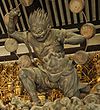
Intangible Cultural Properties
31 techniques
See also
References
- ^ "Law for the Protection of Cultural Properties (1950, last amendment 2007)". UNESCO. http://www.unesco.org/culture/natlaws/media/pdf/japan/japan_law_protectionproperty_entno.pdf. Retrieved 2 May 2011.
- ^ a b "Preservation and Utilization of Cultural Properties". Agency for Cultural Affairs. p. 41. http://www.bunka.go.jp/english/pdf/h21_chapter_06.pdf. Retrieved 2 May 2011.
- ^ a b c Larsen, Knut Einar (1994). Architectural Preservation in Japan. ICOMOS International Wood Committee. pp. 40f. ISBN 82-519-1432-9.
- ^ "Database of Registered National Cultural Properties". Agency for Cultural Affairs. http://www.bunka.go.jp/bsys/maindetails.asp?register_id=304&item_id=9. Retrieved 4 May 2011.
- ^ "Onigawara". Japanese Architecture and Art Net Users System. http://www.aisf.or.jp/~jaanus/deta/o/onigawara.htm. Retrieved 4 May 2011.
- ^ "Database of Registered National Cultural Properties". Agency for Cultural Affairs. http://www.bunka.go.jp/bsys/maindetails.asp?register_id=304&item_id=12. Retrieved 4 May 2011.
- ^ "Kiku". Japanese Architecture and Art Net Users System. http://www.aisf.or.jp/~jaanus/deta/k/kiku.htm. Retrieved 4 May 2011.
- ^ "Database of Registered National Cultural Properties". Agency for Cultural Affairs. http://www.bunka.go.jp/bsys/maindetails.asp?register_id=304&item_id=10. Retrieved 4May 2011.
- ^ "Database of Registered National Cultural Properties". Agency for Cultural Affairs. http://www.bunka.go.jp/bsys/maindetails.asp?register_id=304&item_id=00000074. Retrieved 4 May 2011.
- ^ "Kanagu". Japanese Architecture and Art Net Users System. http://www.aisf.or.jp/~jaanus/deta/k/kanagu.htm. Retrieved 4 May 2011.
- ^ "Database of Registered National Cultural Properties". Agency for Cultural Affairs. http://www.bunka.go.jp/bsys/maindetails.asp?register_id=304&item_id=00000091. Retrieved 4 May 2011.
- ^ "Kinkarakami". Takashi Ueda (Bearer of Technique). http://www5b.biglobe.ne.jp/~kinkara/english.html. Retrieved 4 May 2011.
- ^ "Kinkarakawa". Japanese Architecture and Art Net Users System. http://www.aisf.or.jp/~jaanus/deta/k/kinkarakawa.htm. Retrieved 4 May 2011.
- ^ "Database of Registered National Cultural Properties". Agency for Cultural Affairs. http://www.bunka.go.jp/bsys/maindetails.asp?register_id=304&item_id=00000071. Retrieved 4 May 2011.
- ^ "Tategu". Japanese Architecture and Art Net Users System. http://www.aisf.or.jp/~jaanus/deta/t/tategu.htm. Retrieved 4 May 2011.
- ^ "Database of Registered National Cultural Properties". Agency for Cultural Affairs. http://www.bunka.go.jp/bsys/maindetails.asp?register_id=304&item_id=14. Retrieved 4 May 2011.
- ^ "Database of Registered National Cultural Properties". Agency for Cultural Affairs. http://www.bunka.go.jp/bsys/maindetails.asp?register_id=304&item_id=49. Retrieved 24May 2011.
- ^ "Database of Registered National Cultural Properties". Agency for Cultural Affairs. http://www.bunka.go.jp/bsys/maindetails.asp?register_id=304&item_id=00000073. Retrieved 4 May 2011.
- ^ "Database of Registered National Cultural Properties". Agency for Cultural Affairs. http://www.bunka.go.jp/bsys/maindetails.asp?register_id=304&item_id=00000067. Retrieved 4 May 2011.
- ^ "Clay walls". Omotesenke. http://www.omotesenke.jp/english/chanoyu/4_2_4.html. Retrieved 4 May 2011.
- ^ "Database of Registered National Cultural Properties". Agency for Cultural Affairs. http://www.bunka.go.jp/bsys/maindetails.asp?register_id=304&item_id=1. Retrieved 4 May 2011.
- ^ Yagihashi, Shin (1988). "The Presevation and Handing Down of Traditional Urushi Art Techniques in Japan". Urushi: Proceedings of the Urushi Study Group, June 10-27, 1985, Tokyo. Getty Conservation Institute. pp. 85f. ISBN 0-89236-096-8.
- ^ "Database of Registered National Cultural Properties". Agency for Cultural Affairs. http://www.bunka.go.jp/bsys/maindetails.asp?register_id=304&item_id=4. Retrieved 4 May 2011.
- ^ "Database of Registered National Cultural Properties". Agency for Cultural Affairs. http://www.bunka.go.jp/bsys/maindetails.asp?register_id=304&item_id=00000085. Retrieved 4 May 2011.
- ^ "Database of Registered National Cultural Properties". Agency for Cultural Affairs. http://www.bunka.go.jp/bsys/maindetails.asp?register_id=304&item_id=00000092. Retrieved 4 May 2011.
- ^ "Database of Registered National Cultural Properties". Agency for Cultural Affairs. http://www.bunka.go.jp/bsys/maindetails.asp?register_id=304&item_id=00000066. Retrieved 4 May 2011.
- ^ "Takekugi". Japanese Architecture and Art Net Users System. http://www.aisf.or.jp/~jaanus/deta/t/takekugi.htm. Retrieved 4 May 2011.
- ^ "Database of Registered National Cultural Properties". Agency for Cultural Affairs. http://www.bunka.go.jp/bsys/maindetails.asp?register_id=304&item_id=00000072. Retrieved 4 May 2011.
- ^ "Database of Registered National Cultural Properties". Agency for Cultural Affairs. http://www.bunka.go.jp/bsys/maindetails.asp?register_id=304&item_id=8. Retrieved 4 May 2011.
- ^ "Karakami". Japanese Architecture and Art Net Users System. http://www.aisf.or.jp/~jaanus/deta/k/karakami.htm. Retrieved 4 May 2011.
- ^ "Database of Registered National Cultural Properties". Agency for Cultural Affairs. http://www.bunka.go.jp/bsys/maindetails.asp?register_id=304&item_id=7. Retrieved 4 May 2011.
- ^ "Database of Registered National Cultural Properties". Agency for Cultural Affairs. http://www.bunka.go.jp/bsys/maindetails.asp?register_id=304&item_id=3. Retrieved 4 May 2011.
- ^ "Hyougu". Japanese Architecture and Art Net Users System. http://www.aisf.or.jp/~jaanus/deta/h/hyougu.htm. Retrieved 4 May 2011.
- ^ "Kinran". Japanese Architecture and Art Net Users System. http://www.aisf.or.jp/~jaanus/deta/k/kinran.htm. Retrieved 4 May 2011.
- ^ Koyano, Masako (1979). Japanese Scroll Paintings: A Handbook of Mounting Techniques. American Institute for Conservation. ISBN 978-0933098015.
- ^ "Database of Registered National Cultural Properties". Agency for Cultural Affairs. http://www.bunka.go.jp/bsys/maindetails.asp?register_id=304&item_id=00000084. Retrieved 4 May 2011.
- ^ "Hake". Japanese Architecture and Art Net Users System. http://www.aisf.or.jp/~jaanus/deta/h/hake.htm. Retrieved 4 May 2011.
- ^ "Database of Registered National Cultural Properties". Agency for Cultural Affairs. http://www.bunka.go.jp/bsys/maindetails.asp?register_id=304&item_id=5. Retrieved 4 May 2011.
- ^ "Database of Registered National Cultural Properties". Agency for Cultural Affairs. http://www.bunka.go.jp/bsys/maindetails.asp?register_id=304&item_id=2. Retrieved 4 May 2011.
- ^ "Database of Registered National Cultural Properties". Agency for Cultural Affairs. http://www.bunka.go.jp/bsys/maindetails.asp?register_id=304&item_id=15. Retrieved 4 May 2011.
- ^ "Database of Registered National Cultural Properties". Agency for Cultural Affairs. http://www.bunka.go.jp/bsys/maindetails.asp?register_id=304&item_id=57. Retrieved 4 May 2011.
- ^ "Database of Registered National Cultural Properties". Agency for Cultural Affairs. http://www.bunka.go.jp/bsys/maindetails.asp?register_id=304&item_id=16. Retrieved 4 May 2011.
- ^ "Hyousou". Japanese Architecture and Art Net Users System. http://www.aisf.or.jp/~jaanus/deta/h/hyousou.htm. Retrieved 4 May 2011.
- ^ "Tategu". Japanese Architecture and Art Net Users System. http://www.aisf.or.jp/~jaanus/deta/t/tategu.htm. Retrieved 4 May 2011.
- ^ "Database of Registered National Cultural Properties". Agency for Cultural Affairs. http://www.bunka.go.jp/bsys/maindetails.asp?register_id=304&item_id=47. Retrieved 4 May 2011.
- ^ "Database of Registered National Cultural Properties". Agency for Cultural Affairs. http://www.bunka.go.jp/bsys/maindetails.asp?register_id=304&item_id=56. Retrieved 4 May 2011.
- ^ "Database of Registered National Cultural Properties". Agency for Cultural Affairs. http://www.bunka.go.jp/bsys/maindetails.asp?register_id=304&item_id=00000070. Retrieved 4 May 2011.
- ^ "Database of Registered National Cultural Properties". Agency for Cultural Affairs. http://www.bunka.go.jp/bsys/maindetails.asp?register_id=304&item_id=00000068. Retrieved 4 May 2011.
- ^ "Kazarikanagu". Japanese Architecture and Art Net Users System. http://www.aisf.or.jp/~jaanus/deta/k/kazarikanagu.htm. Retrieved 4 May 2011.
- ^ "Database of Registered National Cultural Properties". Agency for Cultural Affairs. http://www.bunka.go.jp/bsys/maindetails.asp?register_id=304&item_id=13. Retrieved 4 May 2011.
- ^ "Hongawarabuki". Japanese Architecture and Art Net Users System. http://www.aisf.or.jp/~jaanus/deta/h/hongawarabuki.htm. Retrieved 4 May 2011.
- ^ "Database of Registered National Cultural Properties". Agency for Cultural Affairs. http://www.bunka.go.jp/bsys/maindetails.asp?register_id=304&item_id=36. Retrieved 4 May 2011.
- ^ "Kayabuki". Japanese Architecture and Art Net Users System. http://www.aisf.or.jp/~jaanus/deta/k/kayabuki.htm. Retrieved 4 May 2011.
- ^ "Database of Registered National Cultural Properties". Agency for Cultural Affairs. http://www.bunka.go.jp/bsys/maindetails.asp?register_id=304&item_id=35. Retrieved 4 May 2011.
- ^ "Database of Registered National Cultural Properties". Agency for Cultural Affairs. http://www.bunka.go.jp/bsys/maindetails.asp?register_id=304&item_id=6. Retrieved 4 May 2011.
- ^ "Hiwadabuki". Japanese Architecture and Art Net Users System. http://www.aisf.or.jp/~jaanus/deta/h/hiwadabuki.htm. Retrieved 4 May 2011.
- ^ "Kokerabuki". Japanese Architecture and Art Net Users System. http://www.aisf.or.jp/~jaanus/deta/k/kokerabuki.htm. Retrieved 4 May 2011.
- ^ "Database of Registered National Cultural Properties". Agency for Cultural Affairs. http://www.bunka.go.jp/bsys/maindetails.asp?register_id=304&item_id=6. Retrieved 4 May 2011.
- ^ "Database of Registered National Cultural Properties". Agency for Cultural Affairs. http://www.bunka.go.jp/bsys/maindetails.asp?register_id=304&item_id=34. Retrieved 4 May 2011.
- ^ "Database of Registered National Cultural Properties". Agency for Cultural Affairs. http://www.bunka.go.jp/bsys/maindetails.asp?register_id=304&item_id=00000095. Retrieved 4 May 2011.
- ^ "Database of Registered National Cultural Properties". Agency for Cultural Affairs. http://www.bunka.go.jp/bsys/maindetails.asp?register_id=304&item_id=00000080. Retrieved 4 May 2011.
- ^ "Database of Registered National Cultural Properties". Agency for Cultural Affairs. http://www.bunka.go.jp/bsys/maindetails.asp?register_id=304&item_id=00000078. Retrieved 4 May 2011.
- ^ "Dashi". Japanese Architecture and Art Net Users System. http://www.aisf.or.jp/~jaanus/deta/d/dashi.htm. Retrieved 4 May 2011.
- ^ "Database of Registered National Cultural Properties". Agency for Cultural Affairs. http://www.bunka.go.jp/bsys/maindetails.asp?register_id=304&item_id=37. Retrieved 4 May 2011.
- ^ "Database of Registered National Cultural Properties". Agency for Cultural Affairs. http://www.bunka.go.jp/bsys/maindetails.asp?register_id=304&item_id=41. Retrieved 4 May 2011.
- ^ "Database of Registered National Cultural Properties". Agency for Cultural Affairs. http://www.bunka.go.jp/bsys/maindetails.asp?register_id=304&item_id=00000099. Retrieved 4 May 2011.
- ^ "Ishigaki". Japanese Architecture and Art Net Users System. http://www.aisf.or.jp/~jaanus/deta/i/ishigaki.htm. Retrieved 4 May 2011.
- ^ "Database of Registered National Cultural Properties". Agency for Cultural Affairs. http://www.bunka.go.jp/bsys/maindetails.asp?register_id=304&item_id=00000079. Retrieved 4 May 2011.
- ^ "Database of Registered National Cultural Properties". Agency for Cultural Affairs. http://www.bunka.go.jp/bsys/maindetails.asp?register_id=304&item_id=33. Retrieved 4 May 2011.
External links
- (Japanese) Cultural Properties database
- (Japanese) Association for the Conservation of National Treasures
- (English) Association for the Conservation of National Treasures
- (English) Conservation and Repair Projects: systems and planning
Cultural Properties of Japan Tangible Cultural Properties of Japan Designations/Registrations National Treasures of Japan · Important Cultural Properties of Japan · Registered Tangible Cultural Properties of JapanLists Lists of National Treasures of JapanIntangible Cultural Properties of Japan Designations Important Intangible Cultural Properties · Preservers of Important Intangible Cultural PropertiesLists List of Important Intangible Cultural Properties · List of Living National Treasures of Japan (crafts) · List of Living National Treasures of Japan (performing arts)Folk Cultural Properties of Japan Designations/Registrations Lists List of Important Tangible Folk Cultural Properties · List of Important Intangible Folk Cultural PropertiesMonuments of Japan Designations/Registrations Lists List of Special Places of Scenic Beauty, Special Historic Sites and Special Natural MonumentsCultural Landscapes of Japan Designations Lists Groups of Traditional Buildings Designations Important Preservation Districts for Groups of Traditional Buildings · Preservation Districts for Groups of Traditional BuildingsLists List of Important Preservation Districts for Groups of Traditional BuildingsConservation Techniques for Cultural Properties Designations Selected Conservation TechniquesLists List of Selected Conservation TechniquesBuried Cultural Properties Categories:- Japanese culture
- National Treasures of Japan
- Important Cultural Properties of Japan
- Conservation-restoration
Wikimedia Foundation. 2010.


